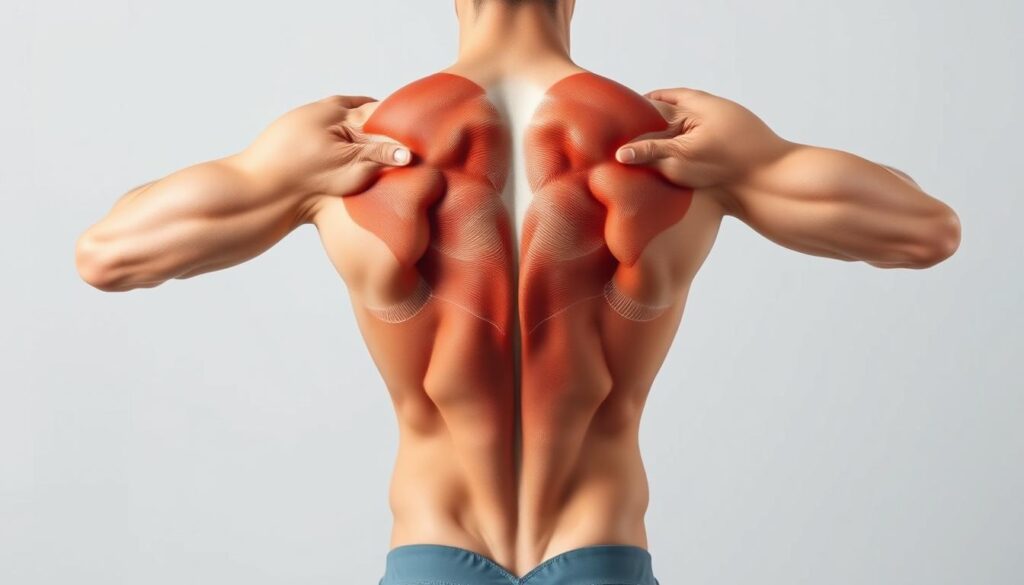Foam rolling is a strong self-help technique for muscle relaxation. It greatly improves upper body health when you make it part of your routine. This method focuses on loosening tight muscles and trigger points in the upper body.
It helps increase blood flow and supports recovery. Learn about foam rolling’s benefits and make it a key part of your health plan.
Introduction to Foam Rolling for Upper Body Wellness
Foam rolling is like giving yourself a massage with a foam roller. It helps ease muscle pain in your upper body. When done regularly, it can make your upper body feel better. This is especially true after working out hard or sitting for a long time.
Effective foam rolling hits key muscles like the shoulders, lats, and back. It’s great for easing pain from bad posture or not moving much. Adding foam rolling to your daily routine brings lots of benefits. It helps make your upper body stronger and healthier.
Benefits of Foam Rolling
Foam rolling helps a lot with upper body health. It eases muscle tightness and helps with trigger points. It makes blood flow better and muscles and joints more flexible, aiding in muscle repair. Also, it’s great for lowering stress, improving mental health for everyone.
Alleviation of Muscle Tightness and Trigger Points
Using a foam roller consistently eases muscle tightness, especially in the upper body. It targets those tough trigger points. This makes you more flexible and improves your range of motion. In the end, it helps you perform better physically.
Increased Blood Flow and Elasticity
Foam rolling boosts blood circulation and makes muscles and fascia more elastic. This speeds up recovery after exercising. It also makes sure your tissues get the nutrients and oxygen they need for top performance.
Promotion of Muscle Recovery
Foam rolling after working out can reduce soreness and improve how you move. If you keep it up, it can also lessen injury risks and make your body stronger. This supports fast and effective muscle recovery.
Stress Relief and Mental Well-being
Foam rolling can make you feel calmer and reduce stress. It has a positive impact on your mental health. Paying attention to your breathing while rolling can make you feel even more relaxed.
Before You Get Started
Getting ready is key to a good foam rolling session. Choosing the right foam roller and setting up your space matters a lot. Knowing which tools to use and how to arrange your area can make a big difference.
Choosing the Right Foam Roller
For beginners, picking a foam roller that’s not too hard is smart. This way, you avoid too much pain while still learning. More experienced people might like a harder roller for a deeper massage. There are also different textures to fit what you like.
Setting Up Your Space
First, make sure you have a good spot for foam rolling. You’ll want enough room, maybe on a soft mat or carpet. It helps to think about what you want from the session, like relaxing or relieving pain. Keep your area free from things that could distract you.
Foam Roller Wellness Routine for Upper Body
Adding a foam roller routine for your upper body can really boost muscle healing and make you more flexible. It works by focusing on tight spots. This helps loosen tension and makes you feel better all over. We’ll cover key exercises for the tight areas we often forget about. These include the upper back, shoulders, lats, and neck.
Essential Moves to Target Tight Areas
- Upper Back Roll: Put the foam roller across under your upper back. Carefully roll it from your neck’s base down to where your lower back starts.
- Shoulder Blade Release: Sit up straight and set the foam roller straight along your spine. Tilt to one side so the roller can work on your shoulder blade area.
- Latissimus Dorsi Stretch: Lay on your side with the foam roller under your armpit. Gently roll it from your armpit to your mid-back, finding the tight spots.
- Neck Stretch: In a sitting position, roll the foam roller under your neck. Move it side to side softly, letting it soothe the neck tension.
Guidelines for Each Exercise
Do each exercise gently, taking deep breaths to help you relax. Aim for about 30 seconds on each area to really help loosen up the tightness. Move slowly, and if you find a sore spot, stay on it to get the most out of your foam roller session. Doing these exercises often will make your wellness routine even better.
Foam Rolling Techniques and Directions
Learning the right way to use a foam roller can improve your upper body fitness. It’s vital to use proper techniques to stretch tight muscles and avoid injuries. Begin by slowly moving over each muscle area, paying special attention to sore or stiff spots.
If you find a spot that hurts a lot, stay there for a few breaths. Giving time for your muscles to ease helps make foam rolling more helpful.
How to Use the Foam Roller Effectively
To get the most out of foam rolling, just follow these simple steps:
- Start with the roller under the muscle area you want to work on.
- Roll gently back and forth, letting the roller move smoothly over your skin.
- Keep an eye on sore areas and change how hard you press if you need to.
- If you find a very tight spot, stay on it for a bit to help it relax.
Identifying Tender Spots
Finding those sore spots is key to a good foam rolling session. Pay attention to any discomfort as you roll. Over time, you’ll likely feel the pain ease up as your muscles relax. If a spot keeps hurting, ease up on the pressure or skip that area. Being mindful like this makes foam rolling safer and more beneficial.
Target Areas for Upper Body Foam Rolling
When you do upper body foam rolling, it’s good to know which muscles to focus on. Working on tight spots helps ease pain and makes you more flexible. Let’s look at the key spots for foam rolling:
Quads and Hip Flexors
Sitting too much can make your quads and hip flexors tight. Foam rolling these parts makes you move better and eases pain. It’s especially good if you sit a lot.
Calves and Hamstrings
Rolling your calves and hamstrings helps make your muscles more flexible. This is very important for athletes. It makes them move better and cuts down on getting hurt during practice.
Upper Back and Lats
Working on your upper back and lats helps with the tension from bad posture. It helps your spine move better and hurts less.
Shoulders and Neck
Focusing on your shoulders and neck can lessen tension. This tension often comes from stress or using a computer too much. It improves how well you can move and can also help with headaches from tight muscles.

Incorporating Foam Rolling into Your Routine
For the best results from foam rolling, make it a key part of your health routine. Try to roll out your muscles two to three times per week. Include it as part of your warm-up before exercising or for cooling down afterward. This routine boosts muscle health and aids in recovery.
Frequency and Timing Recommendations
Being consistent is key to getting the most out of foam rolling. It’s crucial to concentrate on particular muscle groups during each session. Foam rolling can help prepare you for a workout or help you relax afterwards. Doing it regularly can improve your performance.
Combining with Other Recovery Techniques
Besides just foam rolling, mixing it with stretching and mobility exercises can speed up recovery. This blend helps increase flexibility and muscle well-being. By using these techniques together, your body will be better at handling and recovering from physical activities.
Common Mistakes to Avoid
Knowing how to avoid mistakes with foam rolling is key to doing it right. Rolling the wrong way can hurt you instead of helping. By noticing these common slip-ups, you can enjoy all the good stuff foam rolling brings, without the bad.
Using Too Much Pressure
Pushing too hard is a big mistake when you start foam rolling. Some think the harder they press, the better the results. But this can cause bruises or even more pain. It’s better to start easy and slowly add more pressure as your body gets used to foam rolling.
Foam Rolling Injured Areas
You should avoid foam rolling directly on injured or very sore spots. Doing this can make things worse. If rolling makes you hurt more, see a doctor before continuing. Being careful this way helps make foam rolling more beneficial, avoiding simple mistakes.
Conclusion
Adding a foam roller routine to your health plan can greatly improve your upper body health. Foam rolling helps more than just easing muscle pain; it’s key for recovery and overall health. By doing it regularly, you work towards better upper body health and boost your physical performance.
Remember to use the right techniques with foam rolling to get all its benefits. This habit can make moving easier and improve your flexibility in daily life. This lets you enjoy being more active.
Foam rolling is a simple but powerful part of any workout routine. Making time for your upper body wellness with foam rolling can bring big benefits to your physical and mental health. It’s a great tool for anyone serious about staying healthy.



